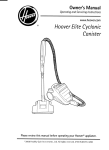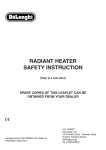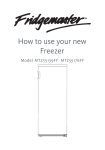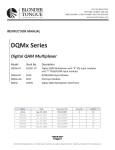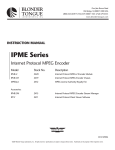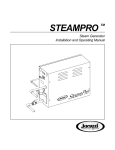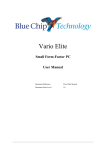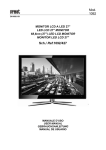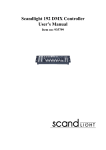Download Hisense MTL55249 refrigerator
Transcript
3 USING YOUR LARDER FRIDGE Switching on your Larder Fridge 1 Before connecting the Larder Fridge to the mains supply make sure that the thermostat control dial, located ins ide the Larder Fridge compartment next to the internal light, is set at position 0 which is Off. 2 Turn the thermostat knob clockwise to set it to the desired position, bearing in mind that the higher the number, the colder the temperature. 3 Wait 24 hours before placing food into the Larder Fridge. Is the Larder Fridge cold enough? Adjusting the temperature The internal temper ature of your Larder Fridge is controlled by a thermostat. Position 7 makes the Larder Fridge coldest. Position 1 makes it warmest and 0 turns the Larder Fri dge Off. The recommended setting for the Larder Fridge is between 3 and 4 for short-term storage and 5 and 6 for long-term. The Larder Fridge may not operate at the correct temperature if it is in a particularly hot or cold room or if you open the Larder Fridge door often. THERMOSTAT &ONTROL DIAL If you are concerned that your Larder Fridge is not being kept cold enough, and wish to check the temperature, you will need a special refrigerator thermometer available from most supermarkets and hardware shops. Place the thermometer in the coldest part of your Larder Fridge and where it can be easily read. Leave overnight, the temperature in the Larder Fridge should be between Ò& and Ò& . See ‘Adjusting the temperature’. Shopping for chilled foods Don’t buy in your lunch hour! Unless you have a Larder Fridge at work to keep the food cold in the afternoon. Leaving food in your car or at room temperature for a prolonged period of time could raise food temperature to the level at which harmful bacteria grow. Keep chilled foods together When you are going around the supermarket and when you are travelling home. If you keep all the chilled foods together they will help to keep each other cold. Use a cool bag Special insulated bags can be bought from most supermarkets and hardware shops. These keep food cold for longer, but are only for getting chilled foods home, not storing it. Unwrap as soon as you get home Always unpack and place chilled foods in the Larder Fridge before storing dry food-stuffs. Noises inside the Larder Fridge If you have not owned a Larder Fridge before, you may notice that it makes some rather unusual noises. Most of these are perfectly normal, but you should be aware of them! Gurgling, whooshing These noises are caused by the circulation of the refrigerant liquid in the cooling system. It has become more pronounced since the introduction of &F& free gases. This is not a fault and will not affect the performance of your Larder Fridge. Humming, purring or pulsating This is the compressor motor working, as it pumps the refrigerant around the system. 4 USING YOUR LARDER FRIDGE Tips for keeping food perfect in the Larder Fridge Where to store your foods in the Larder Fridge Take extra care with meat and fish Cool area Cooked meats should always be stored on a shelf above raw meats to avoid bacterial transfer. Keep r aw meats on a plate which is large enough to collect juices and cover it with cling film or foil. This is where to store foods which will keep longer if they are kept cool. Milk, yogurt, fruit juices, hard cheeses eg, cheddar. Opened jars and bottles of salad dressings, sauces and jams. Fats, eg, butter, margarine, low-fat spreads, cooking fats and lard. Eggs Leave space around food This will allow cold air to circulate around the Larder Fridge. Wrap up food! To prevent transfer of flavours and drying out, food should be separately packed or covered. Fruit and vegetables need not be wrapped. Let pre-cooked food cool properly Always let pre-cooked food cool down before you put it in the Larder Fridge. This will stop the internal temper ature of the Larder Fridge from rising. Shut the door! To prevent cold air escaping, limit the number of times you open the door. When returning from shopping, sort foods to be kept in your Larder Fridge while the door is closed. Coldest area: 0°C to 5°C This is where foods which must be cold to keep them safe should be kept. â Raw and uncooked foods should always be wrapped. â Pre-cooked chilled foods, eg. ready meals, meat pies, soft cheeses. â Pre-cooked meats eg. ham. COOL â Prepar ed salads (including pre-washed chopped, pre-packed mixed green COOL salads, rice, potato salad etc). â Desserts, eg. fromage frais, home-prepar ed food and COLDEST leftovers or cream cakes. SALAD BIN Salad bin This is the most humid part of the Larder Fridge. Vegetables, fruit, fresh salad items eg. unwashed whole lettuce, whole tomatoes, radishes etc. WE RECOMMEND THAT ALL PRODUCE KEPT IN THE SALAD BIN IS WRAPPED . NOTE : ALWAYS WRAP AND STORE RAW MEAT, POULTRY AND FISH ON THE LOWEST SHELF AT THE BOTT OM OF THE LARDER FRIDGE. THIS WILL STOP THEM DRIPPING ONTO, OR TOUCHING, OTHER FOODS. DO NOT STORE INFLAMMABLE GASES OR LIQUIDS. 5 REVERSING THE DOOR SWING The door of your refrigerator can be reversed. . Ensure the fridge is unplugged and empty. . We recommend you have someone to assist you 1 2 3 Tools required . Philips style screwdriver . Flat bladed screwdriver . 8mm socket .10mm socket or spanner When trying to gain access to the base of the fridge, do not tip it back at more than a 45° angle. Rest the fridge on soft foam packaging or similar material to avoid damaging the back of the appliance Remove the four blanking pl ates from the top of the fridge the screws underneath with a Phillips screwdriver. 4 Use the 8mm socket or spanner to remove the three Remove the pin from the bracket and replace it into the same hole from the other side. Remove the fridge door. 6 5 Position 2 Remove the hinge insert plate from the bottom of fridge door. Replace the plate on the opposite side. 7 appliance, secure it with the three bolts, and screw the foot into position. Tilt the fridge back, no more than 45°, to access the bottom hinge and feet. Remove the feet and the bolts securing the right hand hinge plate If the door seal does not against the cabinet, on any side, warm the seal with hot water and tease it into position. This can be done using a hair dryer but care must be taken not to overheat the seal or burn your hands Check the door is aligned horizontally and verically y and that the seal is closed on all sides before tightening hinge bolts. Replace the lid and screws. Remove the hinge pin from position 1 and replace it in position 2. Place the hinge on the opposite side of the cabinet, secure it with the three bolts, and screw in the foot into position. 8 6 CLEANING Cleaning inside the Larder Fridge Switch and unplug the Larder Fridge before cleaning the inside. You should clean the Larder Fridge internall y with a weak solution of bicarbonate of soda. Then rinse with warm wate r using a ‘wrung-out’ sponge or cloth. Wipe the Larder Fridge dry before replacing the food. Plug in and switch on the mains supply. Condensation / frost may form on the back wall of the larder fridge it will normally run down the back wall of the larder fridge and evaporate by itself. Cleaning the outside of the Larder Fridge Use standard furniture polish to clean the Larder Fridge exterior. Make sure that the doors are closed, to prevent polish getting on the magnetic door seal or inside. Do not use harsh cleaners, scouring pads or solvents to clean any part of your larder fridge. Cleaning tips. NOTE Do not use harsh cleaners, scouring pads or solvents to clean any part of the Larder Fridge. TROUBLESHOOTING The Larder Fridge is not working Check it is plugged in and switched on. Check that the fuse in the plug has not blown. Plug in another appliance, such as a lamp, to see if the socket is working. Condensation appears on the outside of the Larder Fridge MAINTENANCE Moving your Larder Fridge Care when handling Hold the Larder Fridge around its sides or base when moving it. Under no circumstance should it be lifted by holding the edges of the top surface. Location Do not locate your Larder Fridge near a heat source, eg. cooker, boiler or radiator. Also avoid direct sunlight. residue of moisture. If the problem continues call the Customer Service Department. Levelling the Larder Fridge Noises Make sure the Larder Fridge is level. Use the rotating levelling feet at the front. If the Larder Fridge is not level, the doors and magnetic seal You may hear some unusual noises from time to time. See ‘Noises inside the Larder Fridge’ on page 3 . If you are not able to identify and eliminate the faults according to the above recommendations, contact the Customer Service Department, advising of model number of the appliance which is shown on the back of the rating plate. Do not attempt to repair your Larder Fridge yourself as it might endanger you and others. Do Not Turn on the Larder Fridge for 2 Hours After the Larder Fridge is in place it needs to be left for 2 hou rs. Servicing Repairs and maintenance of the appliance should only be performed by 7 MAINTENANCE Changing the internal light 1 disconnect the electrical supply. Undo the screw retaining the light bulb cover. Push the cover in and slide toward the rear of the Fridge. Remove the old bulb by unscrewing in an anti-clockwise direction. Replace with a new bulb (15w) by screwing it in a clockwise direction making sure that it is secure in the bulb holder. 6 Replace the light cover and re-insert the screw. 7 Re-connect your Larder Fridge to the electrical supply and switch on. 2 3 4 5 9 SAFETY Safety and warning information Important information when using the appliance Before you switch ON the appliance â This appliance is not intended for use by persons (including children) with reduced physical, sensory or mental capabilities, or experience or knowledge , unless they have been given supervision or instructions concerning the use of the appliance by a person responsible for their safety. Children should be supervised to ensure that they do not play with the appliance. â If the supply cord is damaged, it must be replaced by the manufacturer, its service agent or similarly qualified persons in order to avoid a hazard. â Never use electrical appliances inside the refrigerator (e.g. heater, electric ice maker, etc.). Explosion hazard! â Never use a steam cleaner to clean the appliance.The steam may penetrate electrical parts and cause a short circuit. Risk of electric shock! â Do not store products which contain flammable propellants (e.g. spray cans) or explosive substances in the appliances. Explosion hazard! â Do not stand or support yourself on the base, drawers or doors, etc. â Befo re defrosting and cleaning the appliance,pull out the mains plug or switch off the fuse. Do not pull out the mains plug by tugging the cable. â Commercially frozen pre-packed food should be stored in acco rdance with the frozen food manufacturers instruction. â Bottles containing a high percentage of alcohol must be sealed and stored in an upright position. â Keep plastic par ts and the door seal free of oil and grease. Other wise, the plastic and door seal will become porous. â Never cover or block the ventilation openings for the appliance. â Do not store bottled or canned drinks (especially carbonated drinks) in the ice compar tment .Bottlesand cans may explode! â Never put frozen food, or ice cubes, straight from the ice compar tm ent into your mouth. Risk of frost burns to the lips and tongue! â Avoid prolongedtouching of frozen food, ice or the inner freezer walls or tubing etc. Risk of frost burns to the skin. â Do not scrape off frost or stuck fr ozen food with a knife or pointed object. You could damage the refrigerant tubing. Leaking refrigerant may ignite. Only use a plastic scraper. â In the case of malfunction, under no circumstances should you attempt to repair the appliance yourself. Repairs carried out by inexperienced persons may cause injury or further malfunctioning to the appliance. â When the appliance is unplugged please wait for 5 minutes before plugging it in again. Otherwise, the compressor will be overloaded. Please read the operating and installation instructions carefully. They contain important information on how to install, use and maintain the appliance. Keep all documentation for subsequent use or for the next owner. Technical safety This appliance contains a small quantity of environmentally friendly but flammable R600a refrigerant. Ensure that the tubing of the refrigeration circuit is not damaged during transportation and installation. Leaking refrigerant may ignite. If damage has occurr ed - Keep naked flames and/or ignition sources away from the appliance. - Pull out the mains plug. - Thoroughly ventilate the room for several minutes. - Notify customer services. The more refrigerant an appliance contains, the larger the room must be. Leaking refrigerant can form a flammable gas-air mixture in rooms which are too small. The room must be at least 1m 3 per 8 g of refrigerant. The amount of refrigerant in your appliance is indicated on the rating label on your appliance. â Do not use electricalappliancessuch as a hairdr yer or heaters near your refriger ator. â Do not store inf lammable gases or liquids inside your refrigerator. Children in the household â Keep children away from the packaging and its par ts. Danger of suffocation from folding cardboard and plastic film! â Do not allow children to tamper with the controls or play with the appliance. It is not a toy. Under no circumstances should children be allowed to sit on the bins or hang from the door. â If the appliance featu res a lock, keep the key out of the reach of children. General requirements â The appliance is designedfor domesticuse inside the home and is not intended for commercial or industrial use. â The appliance must be used to store food productsby adults only and according to the instruction manual. â T ry to avoid keeping the door open for long periodsor opening the door too frequently in order to conserve energy. â Do not fill the appliance with too much food: cold air must circulate freely for food to be preserved properly. 10 ELECTRICAL CONNECTIONS THIS APPLIANCE MUST BE EARTHED. If the colours of the wires in the mains lead of this appliance do not correspond with the coloured markings identifying the terminals in your plug, proceed as follows: insert the discarded plug into a socket. Fitting a new plug If for any reason you need to connecte d as shown here. a new plug, the mains lead must be accordance with the following code: The wire which is coloured Green and Yellow MUST be connected to the terminal which is marked with the letter E (Earth) or symbol or coloured Green. The wire which is coloured Blue MUST be connected to the terminal which is marked with the letter N or coloured Black. The wire which is coloured Brown MUST be connected to the terminal which is marked with the letter L or coloured Red. strands of wire inside the plug. Use a 13 Amp BS1362 fuse, only BSI or ASTA approved fuses should be used. If you are in any way unsure which plug or fuse to use, always refer CONNECT GREEN AND YELLOW TO EARTH (E) Note: After replacing or changing a fuse on a moulded plug which has a 13 AMP FUSE CONNECT BLUE TO NEUTRAL (N) CONNECT BROWN TO LIVE (L) MAKE SURE THE OUTER SHEATH OF THE MAINS LEAD IS SECURELY HELD BY THE CLAMP be used without a fuse cover. If lost, replacement fuse covers can be obtained from an electrical shop. This appliance complies with the following EEC Directives: 73 / 23 EEC (Low Voltage Directive) 89 / 336 EEC (EMC Directive).














